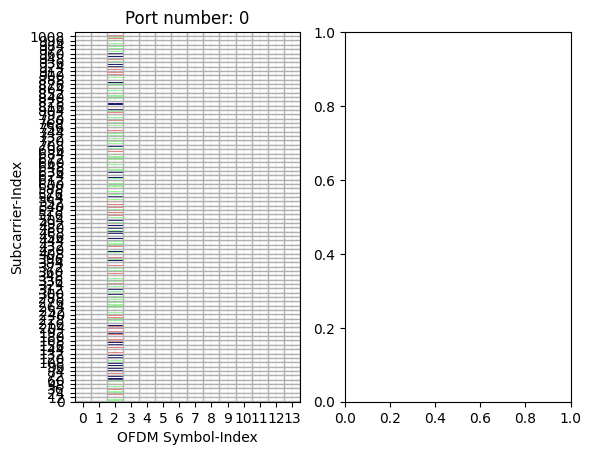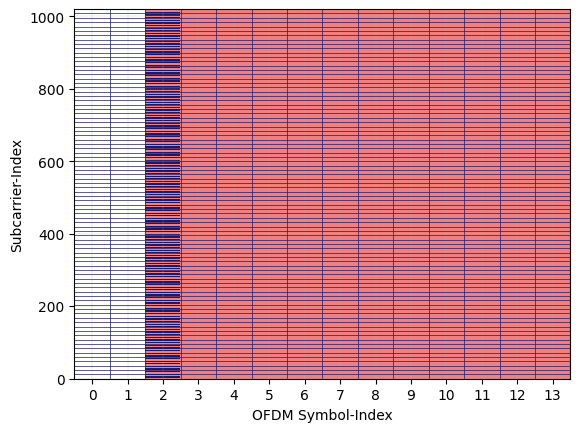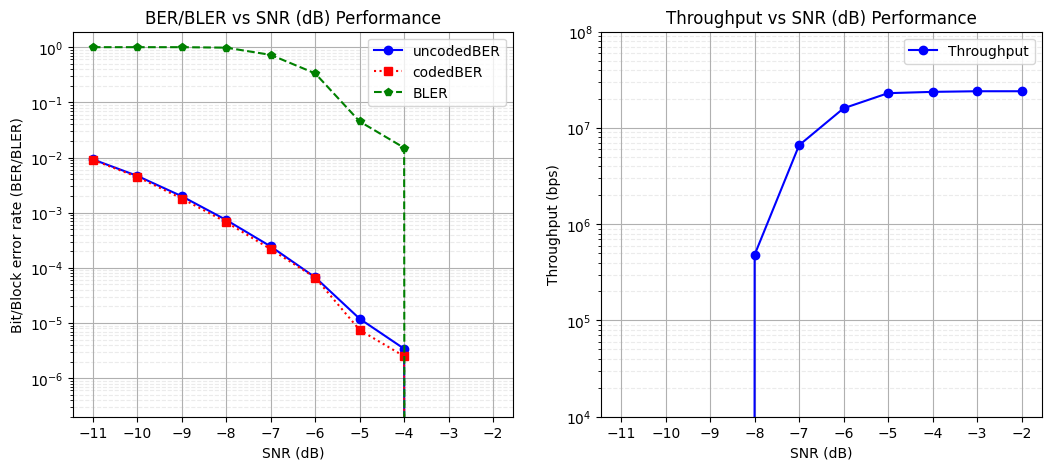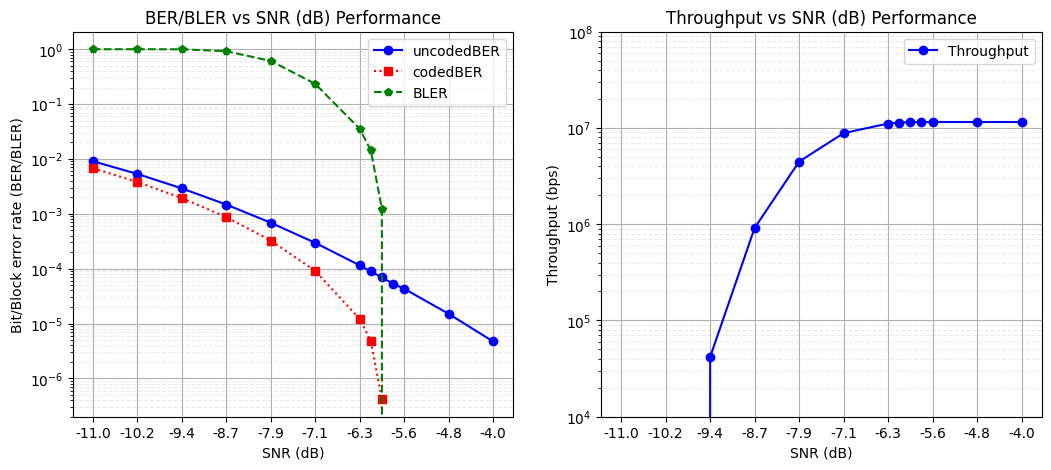Link Level Simulation for Physical Downlink Shared Channel in 5G
Key Performance Parameters - Throughput vs SNR - BLER vs SNR
Import Python Libraries
[1]:
# %matplotlib widget
import matplotlib.pyplot as plt
import matplotlib as mpl
import os
os.environ["CUDA_VISIBLE_DEVICES"] = "-1"
os.environ['TF_CPP_MIN_LOG_LEVEL'] = '3'
import numpy as np
# from IPython.display import display, HTML
# display(HTML("<style>.container { width:80% !important; }</style>"))
Import 5G-Toolkit Libraries
[2]:
import sys
sys.path.append("../../../../")
from toolkit5G.PhysicalChannels.PDSCH import ComputeTransportBlockSize
from toolkit5G.PhysicalChannels import PDSCHLowerPhy, PDSCHUpperPhy, PDSCHDecoderLowerPhy, PDSCHDecoderUpperPhy
from toolkit5G.ChannelModels import AntennaArrays, SimulationLayout, ParameterGenerator, ChannelGenerator
from toolkit5G.Configurations import PDSCHLowerPhyConfiguration, PDSCHUpperPhyConfiguration
from toolkit5G.ChannelProcessing import AddNoise, ApplyChannel
from toolkit5G.SymbolMapping import Mapper, Demapper
Simulation Parameters
[3]:
carrierFrequency = 3.6*10**9 # Carrier Frequency
numBatches = 100 # Number of batches considered for simulation
scs = 30*10**3 # Subcarrier Spacing for simulation
numBSs = 1 # Number of BSs considered for simulation
# Number of UEs considered for simulation
numUEs = numBatches # For now we are assuming that the numbatches are captured via numUEs
numRB = 85 # Number of Resource mapping considered for simulation | # 1 RB = 12 subcarrier
Nfft = 1024 # FFTSize
slotNumber = 0 # Index of the slot considered for simulation
terrain = "CDL-A" # Terrain
txAntStruture = np.array([1,1,4,4,2]) # Tx Antenna Structure
rxAntStruture = np.array([1,1,1,2,2]) # Rx Antenna Structure
print("************ Simulation Parameters *************")
print()
print(" numBatches: "+str(numBatches))
print(" numRB: "+str(numRB))
print(" fft Size: "+str(Nfft))
print(" numBSs: "+str(numBSs))
print(" numUEs: "+str(numUEs))
print(" scs: "+str(scs))
print(" slotNumber: "+str(slotNumber))
print(" terrain: "+str(terrain))
print("Tx Ant Struture: "+str(txAntStruture))
print("Rx Ant Struture: "+str(rxAntStruture))
print()
print("********************************************")
************ Simulation Parameters *************
numBatches: 100
numRB: 85
fft Size: 1024
numBSs: 1
numUEs: 100
scs: 30000
slotNumber: 0
terrain: CDL-A
Tx Ant Struture: [1 1 4 4 2]
Rx Ant Struture: [1 1 1 2 2]
********************************************
Generate Channel
[4]:
# Antenna Array at UE side
# assuming antenna element type to be "OMNI"
# with 2 panel and 2 single polarized antenna element per panel.
ueAntArray = AntennaArrays(antennaType = "OMNI", centerFrequency = carrierFrequency,
arrayStructure = rxAntStruture)
ueAntArray()
# # Radiation Pattern of Rx antenna element
# ueAntArray.displayAntennaRadiationPattern()
# Antenna Array at BS side
# assuming antenna element type to be "3GPP_38.901", a parabolic antenna
# with 4 panel and 4 single polarized antenna element per panel.
bsAntArray = AntennaArrays(antennaType = "3GPP_38.901", centerFrequency = carrierFrequency,
arrayStructure = txAntStruture)
bsAntArray()
# # Radiation Pattern of Tx antenna element
# bsAntArray[0].displayAntennaRadiationPattern()
# Layout Parameters
isd = 100 # inter site distance
minDist = 10 # min distance between each UE and BS
ueHt = 1.5 # UE height
bsHt = 25 # BS height
bslayoutType = "Hexagonal" # BS layout type
ueDropType = "Hexagonal" # UE drop type
htDist = "equal" # UE height distribution
ueDist = "equal" # UE Distribution per site
nSectorsPerSite = 1 # number of sectors per site
maxNumFloors = 1 # Max number of floors in an indoor object
minNumFloors = 1 # Min number of floors in an indoor object
heightOfRoom = 3 # height of room or ceiling in meters
indoorUEfract = 0.5 # Fraction of UEs located indoor
lengthOfIndoorObject = 3 # length of indoor object typically having rectangular geometry
widthOfIndoorObject = 3 # width of indoor object
# forceLOS = True # boolen flag if true forces every link to be in LOS state
forceLOS = False # boolen flag if true forces every link to be in LOS state
# simulation layout object
simLayoutObj = SimulationLayout(numOfBS = numBSs,
numOfUE = numUEs,
heightOfBS = bsHt,
heightOfUE = ueHt,
ISD = isd,
layoutType = bslayoutType,
ueDropMethod = ueDropType,
UEdistibution = ueDist,
UEheightDistribution = htDist,
numOfSectorsPerSite = nSectorsPerSite,
ueRoute = None)
simLayoutObj(terrain = terrain,
carrierFreq = carrierFrequency,
ueAntennaArray = ueAntArray,
bsAntennaArray = bsAntArray,
indoorUEfraction = indoorUEfract,
lengthOfIndoorObject = lengthOfIndoorObject,
widthOfIndoorObject = widthOfIndoorObject,
forceLOS = forceLOS)
# displaying the topology of simulation layout
fig, ax = simLayoutObj.display2DTopology()
paramGen = simLayoutObj.getParameterGenerator()
# paramGen.displayClusters((0,0,0), rayIndex = 0)
channel = paramGen.getChannel()
Hf = channel.ofdm(scs, Nfft, normalizeChannel = True)
Nt = bsAntArray.numAntennas # Number of BS Antennas
Nr = ueAntArray.numAntennas
print(" Number of BSs: "+str(numBSs))
print(" Shape of Channel: "+str(Hf.shape))
print("*****************************************************")
print()

Number of BSs: 1
Shape of Channel: (1, 1, 1, 100, 1024, 4, 32)
*****************************************************
PDSCH Configurations
[5]:
########################################## PDSCH Lower Physical Layer Parameters #########################################
pdschLowerPhyConfig = PDSCHLowerPhyConfiguration(rank = 1, startSymbol=2, numSymbols=12, pdschMappingType = "PDSCH-mapping-type-A",
maxLength = "len1", dmrsAdditionalPosition = "pos0", l0 = 0,
configurationType = "Configuration-type-1")
pdschMappingType = pdschLowerPhyConfig.pdschMappingType # "PDSCH mapping type A" or "PDSCH mapping type B"
maxLength = pdschLowerPhyConfig.maxLength
startSymbol = pdschLowerPhyConfig.startSymbol
numSymbols = pdschLowerPhyConfig.numSymbols
betaDMRS = pdschLowerPhyConfig.betaDMRS
configurationType = pdschLowerPhyConfig.configurationType # "Configuration-type-1" or "Configuration-type-2"
dmrsTypeAPosition = pdschLowerPhyConfig.dmrsTypeAPosition # "pos2" or "pos3"
dmrsAdditionalPosition = pdschLowerPhyConfig.dmrsAdditionalPosition # "pos2" or "pos3"
ld = pdschLowerPhyConfig.ld
l0 = pdschLowerPhyConfig.l0
l1 = pdschLowerPhyConfig.l1
rank = pdschLowerPhyConfig.rank
scramblingID = pdschLowerPhyConfig.scramblingID
nSCID = pdschLowerPhyConfig.nSCID
mcsIndex = 7
mcsTable = "pdschTable1"
########################################## PDSCH Parameters #########################################
pdschUpperPhyConfig = PDSCHUpperPhyConfiguration(pdschMappingType = pdschMappingType, configurationType = configurationType,
dmrsTypeAPosition = dmrsTypeAPosition, maxLength = maxLength, mcsIndex = mcsIndex,
mcsTable = mcsTable, dmrsAdditionalPosition = dmrsAdditionalPosition, l0 = l0,
ld = ld, l1 = l1, startSymbol = startSymbol, numSymbols = numSymbols, rank = rank,
numRB = numRB)
numTBs = pdschUpperPhyConfig.numTBs
numRB = pdschUpperPhyConfig.numRB
tbLen1 = pdschUpperPhyConfig.tbLen1
codeRate = pdschUpperPhyConfig.codeRate
modOrder = pdschUpperPhyConfig.modOrder
mcsIndex = pdschUpperPhyConfig.mcsIndex
mcsTable = pdschUpperPhyConfig.mcsTable
numlayers = pdschUpperPhyConfig.numlayers
scalingField = pdschUpperPhyConfig.scalingField
additionalOverhead = pdschUpperPhyConfig.additionalOverhead
dmrsREs = pdschUpperPhyConfig.dmrsREs
additionalOverhead = pdschUpperPhyConfig.additionalOverhead
numTargetBits1 = pdschUpperPhyConfig.numTargetBits1
if(numTBs == 2):
numTargetBits1 = pdschUpperPhyConfig.numTargetBits1
numTargetBits2 = pdschUpperPhyConfig.numTargetBits2
tbLen2 = pdschUpperPhyConfig.tbLen2
numTargetBits = pdschUpperPhyConfig.numTargetBits
************ PDSCH Parameters *************
pdschMappingType: PDSCH-mapping-type-A
startSymbol: 2
numSymbols: 12
betaDMRS: 1
rank: 1
configurationType: Configuration-type-1
maxLength: len1
dmrsTypeAPosition: pos2
dmrsAdditionalPosition: pos0
Duration, ld: 12
Start symbol, l0: 0
Start symbol-1, l1: 11
num of Layers: 1
********************************************
********************************************
tbsize-1: 12040
numTBs: 1
numCBs: 2
numLayers: 1 | LayerperTB: [1 0]
numRB: 85
coderate: 0.513671875
modOrder: 2
additionalOverhead: 0
numberTargetBits: 23460
********************************************
PDSCH Implementation
This section implements implements both - Upper Physical layer - Lower Physical layer
[6]:
pdschUpperPhy = PDSCHUpperPhy(symbolsPerSlot = numSymbols, numRB = numRB, mcsIndex = mcsIndex,
numlayers = numlayers, scalingField = scalingField,
additionalOverhead = additionalOverhead, dmrsREs = dmrsREs,
numTBs=numTBs, pdschTable = mcsTable, verbose = False)
codeword = pdschUpperPhy(tblock = [None, None], rvid = [0, 0], enableLBRM = [False, False],
numBatch = numBatches, numBSs = numBSs)
rnti = np.random.randint(65536, size=numBSs*numBatches)
nID = np.random.randint(1024, size=numBSs*numBatches)
bits2 = codeword[1] if numTBs == 2 else None
pdschLowerPhyChain = PDSCHLowerPhy(pdschMappingType, configurationType, dmrsTypeAPosition,
maxLength, dmrsAdditionalPosition, l0, ld, l1)
resourceGrid = pdschLowerPhyChain(codeword[0], numRB, rank, slotNumber, scramblingID,
nSCID, rnti, nID, modOrder, startSymbol, bits2 = bits2)
## Load the resource Grid into the transmision Grid
txGrid = np.zeros(resourceGrid.shape[0:-1]+(Nfft,), dtype= np.complex64)
bwpOffset = np.random.randint(Nfft-numRB*12)
txGrid[...,bwpOffset:bwpOffset+numRB*12] = resourceGrid
fig, ax = pdschLowerPhyChain.displayDMRSGrid()
pdschLowerPhyChain.displayResourceGrid()


SVD based Precoding and Beamforming
[7]:
txGrid.shape
[7]:
(100, 1, 1, 14, 1024)
[8]:
# Digital Beamforming
[U, S, Vh] = np.linalg.svd(Hf)
precoder = np.conj(Vh.transpose(3,0,1,2,4,6,5)[...,0:rank])
combiner = np.conj((U*(1/S[...,np.newaxis,:].repeat(S.shape[-1], axis = -2)))[...,0:rank].transpose(3,0,1,2,4,6,5))
xBeam = (precoder@txGrid.transpose(0,1,3,4,2)[:,np.newaxis,...,np.newaxis])[...,0]
print("************ Beamforming Parameters *************")
print()
print(" Precoder Shape: "+str(precoder.shape))
print(" Combiner Shape: "+str(combiner.shape))
print(" Channel Shape: "+str(Hf.shape))
print("Eigen Matrix Shape: "+str(S.shape))
print("Beamformed Grid sh: "+str(xBeam.shape))
print()
print("********************************************")
************ Beamforming Parameters *************
Precoder Shape: (100, 1, 1, 1, 1024, 32, 1)
Combiner Shape: (100, 1, 1, 1, 1024, 1, 4)
Channel Shape: (1, 1, 1, 100, 1024, 4, 32)
Eigen Matrix Shape: (1, 1, 1, 100, 1024, 4)
Beamformed Grid sh: (100, 1, 1, 14, 1024, 32)
********************************************
Pass through the Wireless Channel
[9]:
# Channel Dimensions: numBatches, numFrequencies, numSymbols(numSnapshots), numBSs, numUEs, numSamples/numFFTpoints, numRxAntennas, numTxAntennas
# Tx-Grid Dimensions: numBatches, numFrequencies, numSymbols(numSnapshots), numBSs, numSamples/numFFTpoints, numTxAntennas
# Rx-Grid Dimensions: numBatches, numFrequencies, numSymbols(numSnapshots), -- numUEs, numSamples/numFFTpoints, numRxAntennas
ptc = ApplyChannel(isFrequencyDomain = True, enableInterTxInterference = True, memoryConsumptionLevel = 0)
y = ptc(Hf[np.newaxis].transpose(4,0,1,2,3,5,6,7), xBeam.transpose(0,1,3,2,4,5))
print("************ Channel Parameters *************")
print()
print(" Channel Shape: "+str(Hf.shape))
print("Received Grid shape: "+str(y.shape))
print(" Beamformed Grid sh: "+str(xBeam.shape))
print()
print("********************************************")
************ Channel Parameters *************
Channel Shape: (1, 1, 1, 100, 1024, 4, 32)
Received Grid shape: (100, 1, 14, 1, 1024, 4)
Beamformed Grid sh: (100, 1, 1, 14, 1024, 32)
********************************************
Recevier Side Processing
[10]:
numPoints = 10
SNRdB = np.linspace(-11, -2, numPoints, endpoint=True)
# SNRdB = np.linspace(-13.5, -7.5, numPoints, endpoint=True)
SNR = 10**(SNRdB/10)
codedBER = np.zeros(numPoints)
uncodedBER = np.zeros(numPoints)
bler = np.zeros(numPoints)
throughput = np.zeros(numPoints)
for i in range(numPoints):
print("********************************************************")
print("Simulation: ["+str(i)+"] for SNRdB = "+str(SNRdB[i]))
## Add noise to the received grid
yGrid = AddNoise(False)(y, 1/SNR[i], 0)
## Receiver Combining
rGrid = ((combiner@yGrid[...,np.newaxis])[:,0,...,0]).transpose(0,2,4,1,3)
## Extracting the Received Grid
rxGrid = rGrid[...,bwpOffset:bwpOffset+12*numRB]
## Receiver: Lower Physical layer
isChannelPerfect = False
pdschDecLowerPhy = PDSCHDecoderLowerPhy(modOrder, isChannelPerfect, isEqualized = True)
descrBits = pdschDecLowerPhy(rxGrid, pdschLowerPhyChain.pdschIndices, rnti,
nID, SNR[i], None, numTBs, hard_out = False)
## Receiver: Upper Physical layer
pdschUpPhyDec = PDSCHDecoderUpperPhy(numTBs = numTBs, mcsIndex = mcsIndex, symbolsPerSlot= numSymbols,
numRB = numRB, numLayers = numlayers, scalingField = scalingField,
additionalOverhead = additionalOverhead, dmrsREs = dmrsREs,
enableLBRM = [False, False], pdschTable = mcsTable, rvid = [0, 0], verbose=False)
bits = pdschUpPhyDec(descrBits)
## KPI computation
codedBER[i] = np.mean(np.abs(bits-pdschUpperPhy.tblock1))
uncodedBER[i] = np.mean(np.abs(codeword[0] - np.where(descrBits[0]>0,1,0)))
bler[i] = 1-np.mean(pdschUpPhyDec.crcCheckforCBs)
throughput[i] = (1-bler[i])*tbLen1*2000
print("Simulation: ["+str(i)+"] for codedBER = "+str(codedBER[i]))
print("Simulation: ["+str(i)+"] for uncodedBER = "+str(uncodedBER[i]))
print("Simulation: ["+str(i)+"] for BLER = "+str(bler[i]))
print("Simulation: ["+str(i)+"] for Throughput = "+str(throughput[i]))
print("********************************************************")
print()
********************************************************
Simulation: [0] for SNRdB = -11.0
Simulation: [0] for codedBER = 0.009053156146179402
Simulation: [0] for uncodedBER = 0.009252344416027281
Simulation: [0] for BLER = 1.0
Simulation: [0] for Throughput = 0.0
********************************************************
********************************************************
Simulation: [1] for SNRdB = -10.0
Simulation: [1] for codedBER = 0.004455980066445183
Simulation: [1] for uncodedBER = 0.004647485080988918
Simulation: [1] for BLER = 1.0
Simulation: [1] for Throughput = 0.0
********************************************************
********************************************************
Simulation: [2] for SNRdB = -9.0
Simulation: [2] for codedBER = 0.0018064784053156147
Simulation: [2] for uncodedBER = 0.0019855072463768114
Simulation: [2] for BLER = 1.0
Simulation: [2] for Throughput = 0.0
********************************************************
********************************************************
Simulation: [3] for SNRdB = -8.0
Simulation: [3] for codedBER = 0.0006735880398671096
Simulation: [3] for uncodedBER = 0.0007374254049445865
Simulation: [3] for BLER = 0.98
Simulation: [3] for Throughput = 481600.0000000004
********************************************************
********************************************************
Simulation: [4] for SNRdB = -7.0
Simulation: [4] for codedBER = 0.00021760797342192692
Simulation: [4] for uncodedBER = 0.00024424552429667517
Simulation: [4] for BLER = 0.725
Simulation: [4] for Throughput = 6622000.000000001
********************************************************
********************************************************
Simulation: [5] for SNRdB = -6.0
Simulation: [5] for codedBER = 6.64451827242525e-05
Simulation: [5] for uncodedBER = 6.734867860187553e-05
Simulation: [5] for BLER = 0.33499999999999996
Simulation: [5] for Throughput = 16013200.0
********************************************************
********************************************************
Simulation: [6] for SNRdB = -5.0
Simulation: [6] for codedBER = 7.475083056478405e-06
Simulation: [6] for uncodedBER = 1.1935208866155157e-05
Simulation: [6] for BLER = 0.04500000000000004
Simulation: [6] for Throughput = 22996399.999999996
********************************************************
********************************************************
Simulation: [7] for SNRdB = -4.0
Simulation: [7] for codedBER = 2.4916943521594684e-06
Simulation: [7] for uncodedBER = 3.4100596760443308e-06
Simulation: [7] for BLER = 0.015000000000000013
Simulation: [7] for Throughput = 23718800.0
********************************************************
********************************************************
Simulation: [8] for SNRdB = -3.0
Simulation: [8] for codedBER = 0.0
Simulation: [8] for uncodedBER = 0.0
Simulation: [8] for BLER = 0.0
Simulation: [8] for Throughput = 24080000.0
********************************************************
********************************************************
Simulation: [9] for SNRdB = -2.0
Simulation: [9] for codedBER = 0.0
Simulation: [9] for uncodedBER = 0.0
Simulation: [9] for BLER = 0.0
Simulation: [9] for Throughput = 24080000.0
********************************************************
Simulation Results
[11]:
fig, ax = plt.subplots(1,2, figsize = (12.5, 5))
ax[0].semilogy(SNRdB, uncodedBER, "-b", marker = "o", label="uncodedBER")
ax[0].semilogy(SNRdB, codedBER, ":r", marker = "s", label="codedBER")
ax[0].semilogy(SNRdB, bler, "--g", marker = "p", label="BLER")
ax[0].legend(loc="best")
ax[0].set_xticks(SNRdB)
ytck = (0.1**(np.arange(1, 8))).repeat(9)*np.tile(np.arange(10, 1,-1), [7])
ytck = np.concatenate([[1],ytck])
ax[0].set_yticks(ytck, minor=True)
ax[0].set_yticks(0.1**(np.arange(0, 7)), minor=False)
ax[0].grid(which = 'minor', alpha = 0.25, linestyle = '--')
ax[0].grid(which = 'major', alpha = 1)
ax[0].set_xlabel("SNR (dB)")
ax[0].set_ylabel("Bit/Block error rate (BER/BLER)")
ax[0].set_title("BER/BLER vs SNR (dB) Performance")
ax[1].semilogy(SNRdB, throughput, "-b", marker = "o", label="Throughput")
ax[1].legend(loc="best")
ax[1].set_xticks(SNRdB, minor=False)
ytck = 10**(np.arange(4, 9)).repeat(9)*np.tile(np.arange(1, 10), [5])
ax[1].set_yticks(ytck, minor=True)
ax[1].set_yticks(10**(np.arange(4, 8)), minor=False)
ax[1].set_ylim([10**4, 10**8])
ax[1].grid(which = 'minor', alpha = 0.25, linestyle = '--')
ax[1].grid(which = 'major', alpha = 1)
ax[1].set_xlabel("SNR (dB)")
ax[1].set_ylabel("Throughput (bps)")
ax[1].set_title("Throughput vs SNR (dB) Performance")
plt.show()

Simulation Results: Averaged over 10000 batches
[14]:
from matplotlib.ticker import FormatStrFormatter
filename = "PDSCH-mcsIndex3-rank-1-dB.npz"
dB = np.load(filename)
SNRdB = dB["SNRdB"]
uncodedBER = dB["uncodedBER"]
codedBER = dB["codedBER"]
bler = dB["bler"]
throughput = dB["throughput"]
xticks = np.linspace(-11, -4, 10)
fig, ax = plt.subplots(1,2, figsize = (12.5, 5))
ax[0].semilogy(SNRdB, uncodedBER, "-b", marker = "o", label="uncodedBER")
ax[0].semilogy(SNRdB, codedBER, ":r", marker = "s", label="codedBER")
ax[0].semilogy(SNRdB, bler, "--g", marker = "p", label="BLER")
ax[0].legend(loc="best")
ax[0].set_xticks(xticks)
ax[0].xaxis.set_major_formatter(FormatStrFormatter('%.1f'))
ytck = (0.1**(np.arange(1, 8))).repeat(9)*np.tile(np.arange(10, 1,-1), [7])
ytck = np.concatenate([[1],ytck])
ax[0].set_yticks(ytck, minor=True)
ax[0].set_yticks(0.1**(np.arange(0, 7)), minor=False)
ax[0].grid(which = 'minor', alpha = 0.25, linestyle = '--')
ax[0].grid(which = 'major', alpha = 1)
ax[0].set_xlabel("SNR (dB)")
ax[0].set_ylabel("Bit/Block error rate (BER/BLER)")
ax[0].set_title("BER/BLER vs SNR (dB) Performance")
ax[1].semilogy(SNRdB, throughput, "-b", marker = "o", label="Throughput")
ax[1].legend(loc="best")
ax[1].set_xticks(xticks, minor=False)
ax[1].xaxis.set_major_formatter(FormatStrFormatter('%.1f'))
ytck = 10**(np.arange(4, 9)).repeat(9)*np.tile(np.arange(1, 10), [5])
ax[1].set_yticks(ytck, minor=True)
ax[1].set_yticks(10**(np.arange(4, 8)), minor=False)
ax[1].set_ylim([10**4, 10**8])
ax[1].grid(which = 'minor', alpha = 0.25, linestyle = '--')
ax[1].grid(which = 'major', alpha = 1)
ax[1].set_xlabel("SNR (dB)")
ax[1].set_ylabel("Throughput (bps)")
ax[1].set_title("Throughput vs SNR (dB) Performance")
plt.show()

Save Results
[ ]: